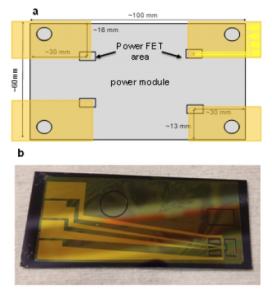Thin Temperature-Sensing Sheets That Can Be Integrated into Power
Researchers demonstrated that thin sheets of material can sense temperature spikes, enabling direct heat measurements in tightly packed power modules. The research was conducted by scientists at the Center for Power Optimization of Electro-Thermal System, an NSF-funded Engineering Research Center (ERC) based at the University of Illinois.
The ability to sense high-temperature spikes within power modules will aid the design of components for reliable and safe operation. The sensors demonstrated by POETS scientists also could become part of commercial products that continuously monitor power modules in scenarios that include mobile electronics.
POETS scientists have focused on temperature sensing as critical for numerous applications in electronics, including the suppression of thermal failures in power modules. Traditional temperature sensors rely on thermocouples or circuit-based sensors that cannot be placed with microscale precision and don’t respond to fast temperature changes.
This research builds on earlier POETS demonstrations of novel transfer techniques for two-dimensional semiconductor materials, resulting in this case of a monolayer coating of 0.6 nm of molybdenum disulfide, or MoS2. The thin, patterned sheets were shown to sense, in real time, the temperature spikes that could damage power modules. POETS has plans to integrate the sensors in power modules produced by Center partners, including Rolls Royce.



